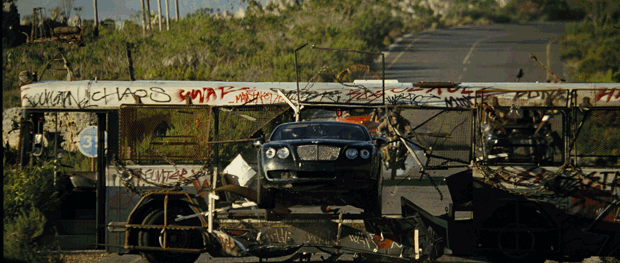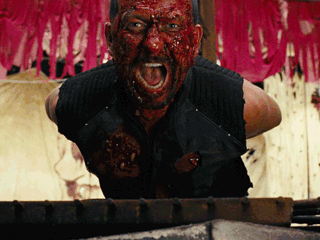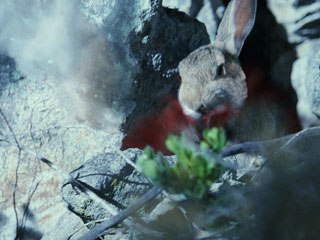Amid the requisite exploding gore in Neil Marshall's new Doomsday, Thomas J. McLean uncovers the subtler vfx deployed by Double Negative to convey a dystopian future Scotland.
In Doomsday (opening today from Rogue Pictures), a government agent goes into a disease-ravaged, barbaric future Scotland in search of a cure. But the biggest challenge facing the visual effects crew in bringing director Neil Marshall's vision to life was turning Cape Town, South Africa, where the film was shot, into a dystopian future Scotland.
VFX Supervisor Hal Couzens says Marshall's approach to the film was to have everything based in reality and all the imagery and effects started with a photographic base. "The film has a lot to do with '80s movies like Escape from New York, The Warriors, Mad Max 2 [The Road Warrior] -- all stunt-based films," he says. "So everything that happens, while fantastical, are things that are happening in a real world 25 years in the future. Everything we designed, special effects-wise, stemmed from that."
The project grew from an initial estimate of about 110 shots to around 275, with most of the work being done by Double Negative. Supervised by Mark Michaels and produced by Clare Tinsley, the London-based shop delivered about 180 shots for Doomsday,with Diccon Alexander as the lead matte painter. While Michaels says their work on the film wasn't innovative in a technical sense, the film required a lot of set extensions that had to be pulled off under tight budget restrictions.
"A lot of the shots were in daylight and it took an extensive amount of set extensions and matte paint extensions, 2D solutions, 3D solutions, to pull it off visually and convincingly," Michaels explains.
"Everything that could have been projected as a texture was done that way rather than building the full 3D model," adds CG Supervisor Alex Pejic.
Michaels suggests the crew made frequent visits to Scotland, taking reference photos of any signature elements in the landscape that could be added into the matte paintings or other elements that would help them make the Cape Town locations used for filming look more like Glasgow. "The two cities are similar but different types of weather add different types of look to the buildings and so forth."
Using Double Negative's proprietary Stig software let Michaels' crew stitch together still photographs into a panorama that could be manipulated, while many of the matte paintings were created in Photoshop and it was all composited with Shake.
Still, the film called for some unusual and challenging scenes. In one such sequence, a flare lights up a landscape that Double Negative had to fill with cows -- the idea being that with no people left, the cow population in Scotland grew unchecked. "We just had a bunch of 2D cows that we shot on greenscreen in the fields and they just had to be placed to fill the entire hillside," Michaels continues.
Another problem came from the wall built to keep the Reaper virus inside Scotland. Marshall asked for a blue-steel look for the wall that was hard to maintain in daylight sequences. Making the wall look like it ran for miles into the distance was another problem.
"There's a flyover of the Scottish hillside up by Loch Katrine and we had to place the wall just running through the hillside for miles and disappear in the distance," Michaels says. Since in the story the wall had just gone up, the look of construction, including roads and vehicles also had to be created and projected onto the shot using 2D techniques.
A 3D version of the wall was built and used for various shots, but the perspective of it going off into the distance posed a lot of tracking challenges. Michaels says they ended up using the 3D version when the wall was near the camera and transition to a matte painting further out.
Couzens says it was a challenge to work with footage of armored personnel carriers, known as APCs, shot in South Africa with plates of London and Glasgow. The difficult part was there was no time or money to use motion control on all the shots, so to make the process easier Marshall limited the camera movement -- which fit well with the director's overall approach.
"What I really liked about this film was how Neil Marshall really worked very much with visual effects and the production designer, Simon Bowles," Couzens says. "We worked as team to work out what we could achieve as a group."
Keeping shots and sequences short also helped the logistics of using multiple houses. Other shops working on the movie were The Senate, VFX Files, Buzz Image, Machine, Finish and Artem. "I think the film benefits massively on a creative level from a visual effects point of view by being able to assign different work to different houses," Couzens says.
The most difficult shot was a scene shot in close up in which one of the characters is burned alive. Michaels says getting the right look was difficult and required a lot of enhancements. Among the elements shot were burning wardrobe, burning pigskin, smoke and fire elements. "It was a bit of a challenge to make it look sort of real and get the interactive lighting to be correct," says Michaels.
In all, between 20 and 30 elements were used in the shot. "The result of it was a very organic feel," continues Couzens. "I'm very in favor of using as many real elements as you can, providing you can combine them effectively in 2D or 3D."
Couzens says another difficult shot was a crash sequence, in which a Bentley crashes through a bus. The shot was planned as an in-camera stunt, but the shot's pyrotechnics ran afoul of dry conditions in the South African nature reserve it was to be shot in. "The fire marshals refused us permission," Couzens adds. "We delayed a couple days hoping for better weather conditions but it wasn't to be the case. That was a moment where we were being asked that question on the set, 'Can we do this as a visual effect?'"
The solution was to build a miniature mock up of the bus at about one-third scale and shoot the miniature and various generic effects with cameras that matched exactly the four cameras used on the pyro-less location shoot. Compositing as many as 20 to 30 elements together was a real challenge, especially with the scene again taking place in daylight, Michaels says.
"In a way, it was probably a good thing because we were able to design an explosion and edit it exactly how we wanted to," Couzens says.
Double Negative also executed a number of establishing shots, including the Thames flood plain in future London, creating a remote Scottish castle from scratch, adding 3D Chinook helicopters, muzzle flashes and some gore.
"There were a lot of blood and gore additions we had to do. Neil Marshall loves his gore!" Michaels says. Various exploding gore effects were shot in front of a bluescreen and composited in to various fight and gun battle sequences.
Nothing, however, was as popular as the "rabbit explosion" scene. Michaels says the scene in question has Sinclair arrive at the Scotland wall, where she sees the guns on automatic sensors that fire upon anything that moves. A rabbit pops out of his hole and is promptly blown to bits.
Michaels says they blew up a bag full of fake blood and cork with some fur built around it, and compositing it with footage of a real rabbit filmed on location. A bit of finessing gave the impression of the rabbit's head and limbs blowing apart, and some bullet hits were added in.
Couzens says the natural inclination of the visual effects crew was to expand the shot, to make it gorier and even turn it into two shots. But Marshall had the good sense to rein in that tendency.
"Neil very specifically said no, because that will make the audience think we've hurt the rabbit and they'll start to feel more sympathy for the rabbit," he says. "By doing it fast, it's comic."
"It always gets a huge laugh," Michaels says. "It was a quick shot, not hugely challenging, but it's a good one."
Thomas J. McLean is a freelance journalist whose articles have appeared in Variety, Below the Line, Animation Magazine and Publishers Weekly. He writes a comicbook blog for Variety.com called Bags and Boards, and is the author of Mutant Cinema: The X-Men Trilogy from Comics to Screen, forthcoming from Sequart.com Books.











